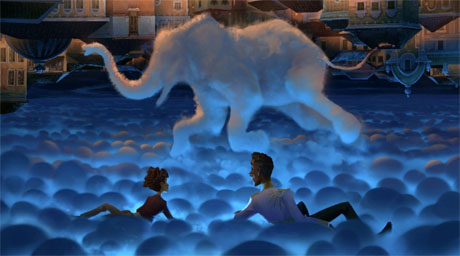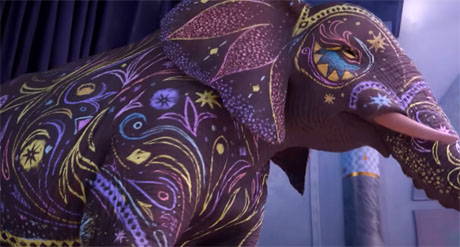
Fairy tales have been genuinely magical of late. First, we got the charm, humor, and animation brilliance of Puss In Boots: The Last Wish, an overwhelming critical and box office success. Then, in early 2023 we are treated to The Magician’s Elephant, helmed by first-time director Wendy Rogers. Rogers has been involved with animation and visual effects since the early 1990s. She did not have an easy task. The film, based on a book by novelist Kate DiCamillo, was first slated for adaption into a movie as far back as 2009. Julia Pistor signed on as producer, but the film sat in production hell until 2020 when Netflix stepped in to assist Pistor in getting the film done. Animal Logic was chosen to produce the animation, industry vet Martin Hynes took on the screenplay, and things happened quickly afterward.

The filmed story is not overly complex: The Magician’s Elephant, in fact, has the structure of a fairy tale in which the hero must complete three impossible tasks to find the maiden fair, and naturally, magic is involved. This structure is flavored by the maxim that nothing is impossible if you believe in yourself. A ten-year-old boy named Peter (Noah Jupe) is the tale’s hero, and he lives in the fictional Mittle-European town of Baltese. Baltese is a joyless town, its color, and vibrancy robbed by some sort of curse in the form of thick, blanketing clouds.
Peter is under the care of bitter old soldier Vilna (Mandy Patinkin), who rescued the infant Peter during a past war. He is unrelenting in training Peter to have the habits – and coldness – of a warrior. Peter cares only about finding his long-lost sister Adele (Pixie Davies). Vilma has told Peter that she was killed in the same battle that Vilna rescued Peter from, but Peter thinks differently. He feels her presence, and it is all-consuming to him. While on an errand, Peter sees an unfamiliar red tent whose inhabitant can foresee the future. For one coin, the fortune teller (Nastasia Demetriou) gives Peter this cryptic advice: “Follow the Elephant!” The creature will somehow help Peter find Adele.
A pity that there is no elephant anywhere in the vicinity of Baltese — until an inept magician (Benedict Wong) accidentally conjures one up (and drops it on a stage “volunteer,” crushing her legs. The angry townspeople capture the elephant and imprison it in the town hall under the watchful eye of the mayor until the king (Aasif Mandvi) gets word of the miraculous animal. Peter, aided by the mayor’s top assistant Leo (Brian Tyree Henry) and his wife Gloria (Sian Clifford), begs that the animal be released to him, and the king agrees – if Peter can perform three impossible tasks; a tall order for a 10-year-old boy! Meanwhile, Adele, now under the care of a fidgety nun (Dawn French), is having dreams about an elephant…

It’s difficult to fault this script and kudos to Julia Pistor for sticking with the project for as long as she did; it was well worth the time and effort. Liberties were taken with DiCamillo’s text, but that is the same story with most film adaptations. The film’s faults lie with Animal Logic, a studio that has worked on seemingly every big release over the past few years. The elephant is beautifully rendered and amazingly realistic in its every appearance. (especially when dolled up in a psychedelic paint job!) The same cannot be said about human characters.
The opening minutes of the film feature stiff and unrealistic movements; perhaps a different team of animators worked on that introductory sequence. Much (but not all) of this is remedied as the film progresses. The human characters appear more like animated dolls with stiff, unmoving hair and large eyes. Facial expressions are more in the realm of passable than good. The exception is the magical fortune teller, who seems animated at a cut above.
Details of the production design are sometimes distracting; Baltese is supposedly under a morale-sapping curse that drains the town of color. However, in many sequences, the hues of Baltesian architecture are as colorful as before. The story is set in what appears to be some eighteenth-century timeframe, but many of the townspeople wear clothing far too modern. A scene set inside Leo and Gloria’s kitchen has what seems to be abstract art on the wall.

To be fair, some scenes are outstanding; the elephant dreams of his far-off family performing an aquatic ballet, and Peter’s teetering on the roof of what seems to be the tallest building in the city is breathtaking. Unfortunately, the animation lacks internal consistency, but even that does not blunt the simple but powerful message of the story: Believe in yourself, and all things are possible.
The vocal performances are strong overall. Jupe expresses despair, determination, and joy equally well. Natasia Demetrious stands out as the fortune teller without resorting to an imitation of Maria Ouspenskya. Brian Tyree Henry is enthusiastic enough, and Benedict Wong gets to play another sorcerer in his crossover from the MCU. He is generally excellent. The two best performances belong to Mandy Patinkin as Vilna and Aasif Mandvi as the king. Patinkin’s performance is emphatic and guilt-ridden by turns. Mandvi is in flighty, off-the-wall mode; his capriciousness goes up to 11, and he is always at full speed.
In short, if one takes the animation and production design as par for the course in a Netflix children’s movie, many pleasures can be found in The Magician’s Elephant. It plays better than most animated dross doled out over the past year and contains no farts or social-media-based in-jokes. It’s a throwback, but it’s a very good one.
- ANIME REVIEW: “Lonely Castle in the Mirror” - September 24, 2023
- REVIEW: “Teenage Mutant Ninja Turtles: Mutant Mayhem - August 15, 2023
- REVIEW: “Spider-Man: Across The Spider-Verse” - June 7, 2023


 March 16th, 2023
March 16th, 2023  Martin Goodman
Martin Goodman  Posted in
Posted in  Tags:
Tags: 






